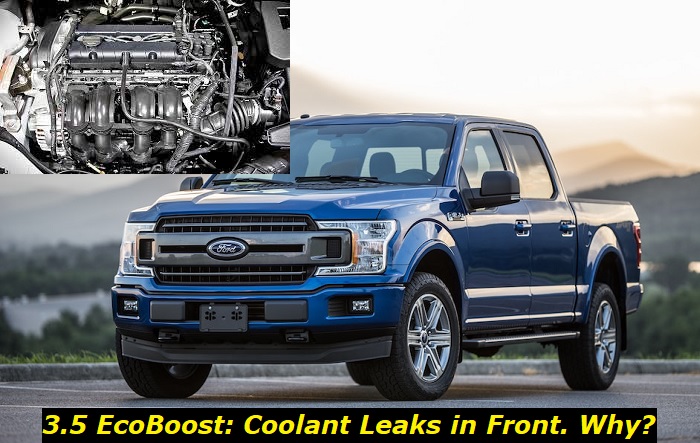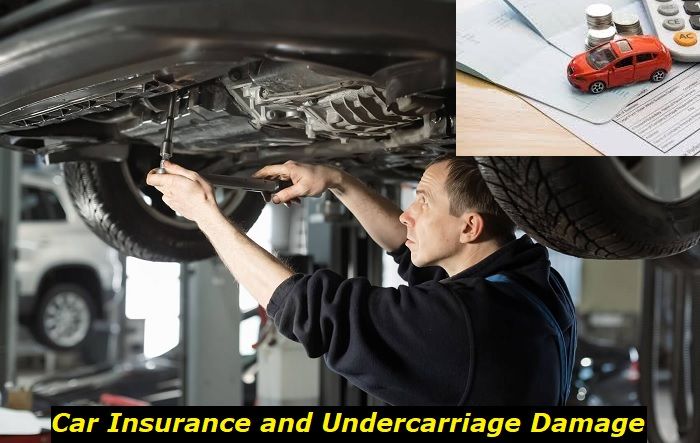It can be frustrating to see puddles of coolant leak underneath your car. These leakages plague the EcoBoost engines, especially the 3.5L.
Key features and my opinion about the engine
- Production years:2010-now
- Average lifespan of 3.5L EcoBoost:190,000-220,000 miles
- Fuel supply type:direct injection
- Power range:310-660 hp
- Fuel efficiency:average
- Engine block material:aluminum
- Engine reliability score:medium
- The most common problems:intercooler problems, timing chain stretching, carbon buildup on intake valves, coolant and oil leaks.

How Does the 3.5L EcoBoost Cooling System Work?
The 3.5L EcoBoost cooling system works like most vehicle cooling systems. It is designed with a thermal siphoning water cooling system that allows coolant flow when the engine is still running. Once the engine is turned off, the water pump is turned off, and the coolant flow reverses.
Furthermore, the cooling system consists of various components that work closely together. When one of these components is damaged, the entire cooling may fail. These components include:
1) Water pump
The water pump helps circulate coolant through the turbo engine. A belt is connected to the crankshaft and will pump coolant as long as the engine runs.
2) Radiator
The radiator function as a heat regulator, transferring heat absorbed by the coolant and dispersing it to the surroundings. Within the radiator, small hoses and tubes allow coolants to flow through it. As the coolant flow through these tubes, it is cooled off by cool air absorbed from the surroundings.
3) Thermostat
The thermostat is a valve located between the radiator and the engine. It works by circulating coolant within the engine when it is cold. When the coolants' temperature rises beyond a certain threshold, the thermostat valve opens and allows the coolants to flow to the radiator.
4) Coolant hose or line
These lines transfer coolants between different components within the cooling system.
5) Coolant reservoir
The coolant reservoir is a tank or container that stores excess coolant not circulated at the time. As the coolant is heated, it expands, and excess enters the reservoir. Conversely, more coolant is drawn from the reservoir when it cools down.
Discussing these components allows you to properly diagnose the causes of the leaks, as they will most likely be traced to one or more of these components.
What causes Coolants to leak in front of the 3.5 EcoBoost engine?
Diagnosing the actual cause of the leak can be very misleading without the proper know-how. For instance, a hose connector may be broken under the fluid tank. These fluids can then flow to other components, causing an illusion that leaks are happening from different cooling system parts.
We recommend physically inspecting all these parts to determine the actual cause. The common causes of coolant leaks in front of the engine are:
1. Damaged Reservoir connector
Underneath the reservoir tank is a fitting that distributes coolant via a hose. The fitting between the hose and the reservoir may be damaged. A worn-out O-ring within the fittings often causes it.
If you notice coolant droplets coming from this area, fixing it should not be an issue. I recommend changing the entire fitting to be sure you have fixed the leakage. Or you can just replace the O-ring within the fittings.
How to fix it?
- Lose the c-clamp over the fitting and detach the connection.
- Within the hose connector, remove the old O-ring. You should notice physical deterioration on the ring.
- Allow some of the excess coolant to leak from the hose.
- Fix a new O-ring into the connector and attach it to the reservoir tank
- Ensure to fasten the c-clamp over the fitting.
- Start the car and allow it to run at normal temperature. Check if the leak continues.
2. Damaged Thermostat
If you spot the leak close to the thermostat housing, it's likely a damaged thermostat or hose leading to the water pump. We described the thermostat as a temperature-sensitive valve that regulates the coolant's heat. The valve opens when the coolant's heat hits a certain threshold allowing the flow into the radiator, and closes when the engine is cold.
A damaged thermostat means that the valves do not correctly open or close. When closed, the coolant heats up with no escape while the water pump pumps coolant. Overheating coolant and further damage can cause the hose or lines to break.
How to fix it?
Getting to the thermostat isn't easy work and will require taking apart many engine components. Here is what to do:
- Remove the intake hoses over the radiator to create space to work.
- Drain the coolant that is circulating in the engine.
- Take off the thermostat housing covering the thermostat.
- Replace with a new thermostat. Also, replace the old gasket around the thermostat housing.
- Assemble and tighten all components back to their original position.
3. Damaged Water Pump
Water pumps are a major cause of coolant leaks at the front of the engine. But the problem is, they are not easy to spot. The leaking usually comes from the wheat pole above the water pump pulley.
You would usually notice a wet spot or corrosion over the front cover of the water pump that indicates the water pump is leaking. The water pump is located in the front of the engine and has a pulley where the engine fan is connected.
Furthermore, Ford suggested that the EcoBoost water pump be replaced over 100,000 miles traveled. So, if your water pump is older, you must replace it quickly.
A water pump failure can be caused by a damaged thermostat (explained above), a radiator, or a damaged head gasket.
How to fix it?
If you have identified that the water pump is responsible for the coolant leak in your vehicle, you will have to replace it with a new one.
Please, bear in mind that depending on the year or model of your 3.5L EcoBoost engine, water pumps may be different.
There are two types of water pumps, i.e., ones with 4-pulley (Usually 2011-2016) and 3-Pulley (2017-till date).
4. Faulty Turbo Fittings
Cooling fittings on the turbo are not designed to last more than 150,000 miles. You must lose both turbos on the 3.5l EcoBoost engine to fix the cooling fitting. However, this leakage often appears on the passenger rear side, rather than under the front hood. They should be the last place you check on your vehicle. Fixing this issue requires professional experience, and I recommend you visit a good shop instead.
5. Blown radiator hose
The radiator has various hoses that circulate coolants to various cooling system components. Furthermore, the cooling system operates under a certain pressure. Once the pressure is raised, the coolant is pushed to the radiator.
However, if the hose is compromised or old and worn out, it may break and cause coolants to leak into the engine or outside. When this happens, there is a rapid loss of coolant and significant leakage. The fix is identifying the blown radiator hose and replacing it with a new OEM hose.
How do you replace a damaged Radiator?
While is discussed earlier that a blown radiator hose may be responsible for the leak in your vehicle. A damaged radiator is likely responsible for the leak, too. How do you replace a damaged radiator? Here is how you do it:
- Let the engine cool for a few minutes. I recommend anything from 10 minutes
- Locate your radiator. It is usually located at the front of the engine. (You won't miss it!)
- Make sure to disconnect the battery before you proceed to do anything.
- Get your fluid pan and drain excess coolant within the radiator
- Now, lose all hoses attached to the radiator and remove the old thermostat. You will need to replace that too.
- Depending on your car, if the fan is mounted on the radiator, you should disconnect the fan too.
- Unbolt the fan bracket and remove it.
- Proceed to remove the radiator. Ensure that all nuts and bolts holding the radiator are removed.
- Attach the fan bracket to the new radiator
- Install the new radiator and bolt to its place.
- Proceed to install the fan and attach all disconnected hoses to the radiator.
- Don't forget to replace the thermostat with a new one.
- Fix the battery into the car and start the vehicle. Make sure the cap of the radiator is still off. This allows air within the coolant to escape as it heats up.
- Once the bubble is out, you can then close the radiator cap.
- Check for any more leakages, and you are good to go!
Should you continue to drive with a coolant leak?
Yes, you can drive with coolant leaks, depending on the severity of the leak. However, I would not recommend you neglect your coolant leaks. Although less significant, coolant leaks can develop into more severe issues that cost money.
Final Thought
There you go! You should be able to spot the cause of the coolant leak in the front of your 3.5L EcoBoost engine. We have also identified some of the components of the cooling system and some remedies for the leakage. Should you still find it difficult to fix the leakage on your vehicle, please seek professional help immediately.
About the authors
The CarAraC research team is composed of seasoned auto mechanics and automotive industry professionals, including individuals with advanced degrees and certifications in their field. Our team members boast prestigious credentials, reflecting their extensive knowledge and skills. These qualifications include: IMI: Institute of the Motor Industry, ASE-Certified Master Automobile Technicians; Coventry University, Graduate of MA in Automotive Journalism; Politecnico di Torino, Italy, MS Automotive Engineering; Ss. Cyril and Methodius University in Skopje, Mechanical University in Skopje; TOC Automotive College; DHA Suffa University, Department of Mechanical Engineering






Add comment